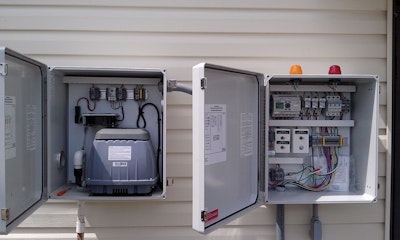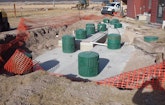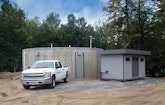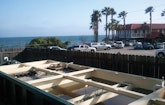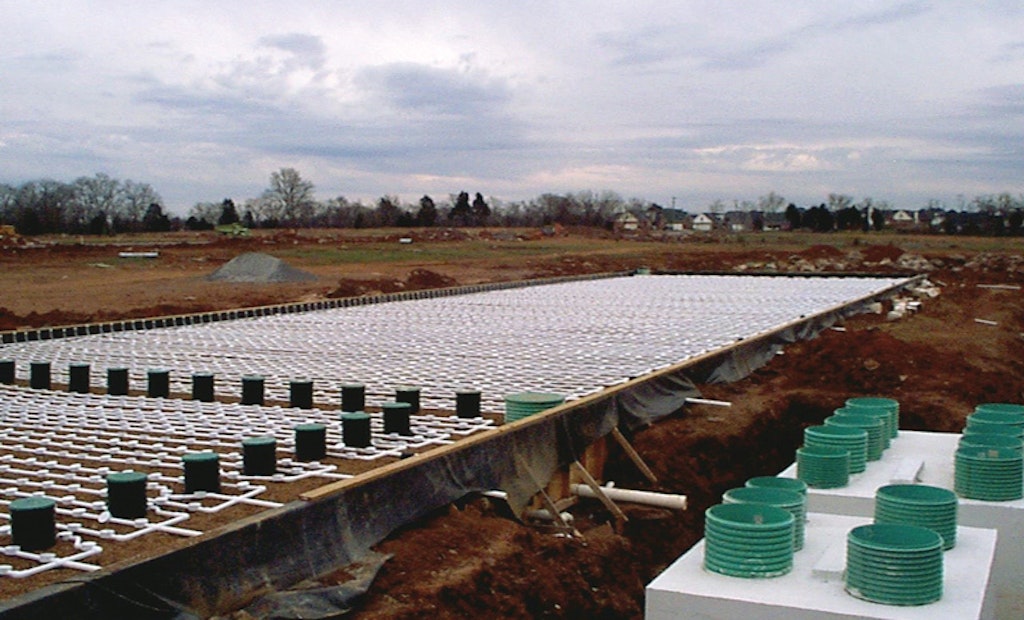Interested in Pumps?
Get Pumps articles, news and videos right in your inbox! Sign up now.
Pumps + Get AlertsLarge-scale onsite system serves a Tennessee subdivision
Problem: Diamond Crest Homes, a subdivision located on the outskirts of Murfreesboro, Tenn., called for 199 homes on a large property. There was no municipal sewer to connect to for disposal.
Solution: The developers contacted Clarus Environmental, a division of Zoeller Company, with the challenge. Working with the local health department and engineers, a 55-foot by 212-foot by 42-inch media filter with drip disposal was designed and installed to accommodate the subdivision. Each home is equipped with a STEP system that feeds a pressure main and is then transported to the media filter. From there, pumps take over and dose the media filter with 20 percent of the treated effluent draining into the disposal tanks.
Result: The treated effluent is disinfected through a series of UV treatment devices before heading to the 10-acre drip field. The drip field is zoned and alternates for equal dispersal. Operators report no issues with the system. 800/928-7867; www.clarusenvironmental.com.
Sequencing batch reactor system allows for expansion of Indiana meeting facility
Problem: Located near Batesville, Ind., Walhill Farm offers facilities for parties and business functions in a country setting. The 141-acre working farm includes a banquet facility in a renovated horse barn that seats 800 people, a restaurant and a butcher shop. The conversion came in 2012, and the butcher shop was added, requiring a new onsite wastewater treatment system.
Solution: Kevin Chaffee, P.E. of Earthtek Environmental was hired to design the system. Since the wastewater strength from the butcher shop was expected to exceed domestic concentrations, it had to be treated prior to soil disposal. A package sequencing batch reactor called the Sabre (Sequencing Activated sludge Batch Reactor) was used to pretreat the wastewater. It is designed to be installed in a conventional septic tank, and can be adapted for almost any application. The system consists of fine-bubble aeration, simplex or duplex decant pumps installed in the tank clear zone, and a digital control panel with integral air pump.
Result: The system reduced BOD concentrations from a design level of 800 mg/L to 15.6 mg/L, TSS from 400 mg/L to 11.7 mg/L, and effluent ammonia to 0.078 mg/L. 812/528-8784; www.packageplants.com.
Denitrification units allow popular Montana steakhouse to expand
Problem: Lou Caissey, owner of the Grub Stake, a steakhouse in Helena, Mont., wanted to expand the restaurant to serve a growing clientele. His goal was to maximize seating area while working within the constraints of a small lot served by an existing onsite system.
Solution: Caissey decided to retrofit with new septic tanks and dual Eliminite 620 C advanced denitrification units. The Montana Department of Environmental Quality allowed doubling the application rate to the sub-surface soil absorption system if Eliminite advanced treatment units were utilized to remove BOD, TSS and nitrogen prior to discharge.
Result: The contractor was able to coordinate the project so that the restaurant was not shut down during the retrofit. Installation of the new septic tanks and Eliminite treatment units was completed in four days, and the owner achieved his goal of working with the small lot and using the existing drainfield. 888/406-2289; www.eliminite.com.
Geosynthetic aggregate bundles provide solution for Arch Coal-Viper Mine
Problem: The Arch Coal-Viper Mine in Williamsville, Ill., needed to expand its workforce and build a new changing facility with restrooms and showers. The existing small and outdated wastewater treatment system was unable to handle the anticipated daily flow of 3,600 gpd. Tie-in to the local sewer at a cost of more than $300,000 was too expensive and did not meet the goal of on-site treatment of all waste from mine operations. Seasonal high groundwater levels, poor soils and limited space were also challenges.
Solution: Mine owners turned to Rick Maguire of Maguire Backhoe Company in Virden, Ill., for a solution. Maguire suggested installing a new subsurface system including a 5,000-gallon concrete tank, a 5,000-gallon single-compartment dose tank, duplex pumps and a shallow drainfield incorporating 4,200 feet of EZflow by Infiltrator geosynthetic aggregate bundles. Pressure dosing in alternating zones allows the beds to rest between dosings and reduces biomat development. The system is installed in a 20-foot-high, 600-foot-long berm of clay-loam soil left over from the original mine excavation. No aggregate was used. An Aquaworx IPC Controller enables ongoing system monitoring and management.
Results: The large pressurized system cost half of what it would have to extend sewer lines to the site. 800/221-4436; www.infiltratorsystems.com.
New Hampshire town installs passive treatment system
Problem: The Town of Newbury, N.H., needed to expand its Blodgett Landing Municipal Treatment Plant due to a growing community and higher treatment standards, including denitrification. With a small budget and limited space, the town had to find a product to handle 50,000 gpd and meet all of these requirements. Also required was a product that would be easy to maintain with minimal upfront and ongoing costs.
Solution: The town decided to upgrade its system to a series of passive Enviro-Septic treatment beds from Presby Environmental designed for 50,000 gpd. The addition of recirculation pumps allowed the town to achieve denitrification and treatment.
Result: The system was able to treat the town’s effluent to the following levels: TSS is 6, BOD is 5, TKN is less than 0.05, and E. coli is less than 1. According to Plant Manager Tim Mulder, “The upfront cost saving with minimal ongoing cost and maintenance is exceptional. We are very pleased.” 800/473-5298; www.presbyenvironmental.com.
Disinfection needs solved at Malibu restaurant
Problem: Located on the oceanfront in Malibu, Calif., Duke’s is a popular restaurant, dedicated to Duke Kahanamoku, the father of surfing. Wastewater from the restaurant averages 6,000 gpd, and must be treated on site and directly discharged to the sensitive beach environment. The existing wastewater treatment system was outdated and was causing numerous water quality and discharge violations.
Solution: Carlile-Macy was selected to provide an upgraded treatment system in 2011. They chose an upflow sludge blanket filtration system, USBF, and Salcor UV disinfection, consisting of four 3G units in two parallel tracks. The design was approved by the CA Regional Water Quality Board and City of Malibu, and construction of the new plant was completed in April 2012.
Result: The system immediately produced high-quality effluent, which has met the stringent disinfection requirement of CA Title 22. Results have been consistent for the first 15 months of operation. Effluent total coliform count has been non-detectable, and the dissolved oxygen concentration has averaged 6 mg/L. The discharge has reduced coliform levels in the groundwater lens under the site and adjacent beach from more than 1600 mpn to less than 2 mpn. The UV units are inspected weekly for possible fouling of the Teflon barrier and no fouling has occurred. 760/731-0745.
Trickling filter system meets needs of Canadian high school
Problem: Installed in 2000, the onsite system at Erin District High School in Erin, Ontario, Canada, consisted of suspended growth – extended aeration treatment, an anoxic chamber with methanol addition for nitrogen removal, an intermittent sand filter for polishing and subsurface disposal. Despite capital improvements to the plant in excess of $100,000 over eight years, this system was causing a number of issues for the Upper Grand School District. Nitrogen levels in the effluent were consistently over limits, the plant required high annual O&M costs, and students and teachers often complained of odors and noise emanating from the plant.
Solution: Through the Ontario Green Schools Pilot Initiative, the school hired Waterloo Biofilter Systems to replace their existing system with a more environmentally friendly option. In 2010, the existing aeration system was decommissioned and replaced with a 10,500 gpd absorbent trickling filter, a WaterNOx system, for enhanced nitrogen removal and a demonstration wastewater reuse system.
Result: The system has been consistently meeting effluent limits since installation. The passive nature of the system reduced electrical use by 85 percent and operating costs by 65 percent, resulting in annual O&M savings to the district of over $37,000. Nuisance odor and noise complaints have also been eliminated. 866/366-4329; www.waterloo-biofilter.com.
Advanced treatment unit maximizes available space at Canadian campground
Problem: Expansion plans doubling sites at the Camping des Sources campground in Whickam, Quebec, Canada, caused a tenfold increase in wastewater volume. The campground required a robust system with the smallest footprint possible to maximize campsite numbers. The solution needed to provide high-quality effluent to meet permissible discharge into a sensitive area. Finally, the treatment system would need to be easily shut down in the winter and restarted rapidly in the spring.
Solution: The campground chose the Ecoprocess SBR from Premier Tech Aqua. It consists of a single round concrete tank measuring 29 feet in diameter. MCi Engineering & Construction in Trois-Rivières was the general contractor. The compact system is comprised of a primary reactor, an equalization tank and a True Batch and intermittent discharge Ecoprocess SBR. Six Hallet 30 units from UV Pure and a coagulant-dosing pump ensure disinfection and phosphorous removal for final disposal into a nearby waterway.
Result: Wastewater is treated efficiently without reducing the number of campsites. Silent and odorless, the system is easy to operate and maintain. A control panel monitors each component and notifies the campground and system maintainer simultaneously if action is required. 800/632-6356; www.premiertechaqua.com.
